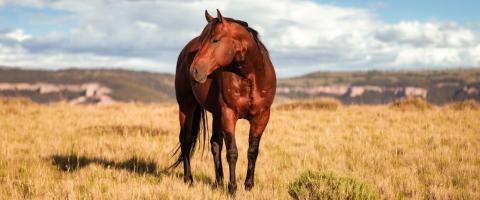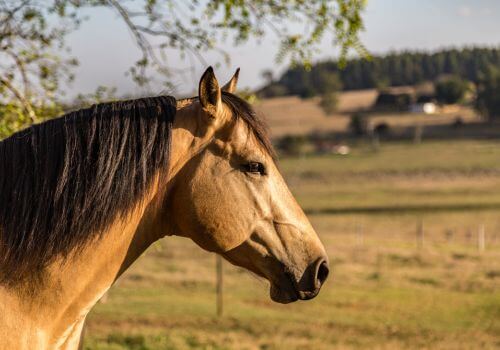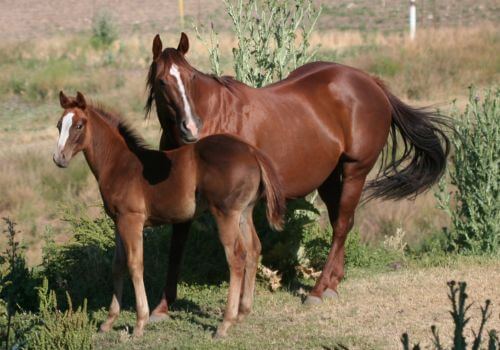
Meet the American Quarter Horse: America’s Favorite Ride!
- Weight: 950 to 1,200 pounds
- Height: 14.3 hands (56 inches) to 16 hands (64 inches)
- Body Type: Muscular build; deep chest; small head with a wide forehead and flat profile
- Best For: Working, family, and show
- Life Expectancy: 25 years or longer
From Ranch to Racetrack: The Quarter Horse’s History

The American Quarter Horse is one of the oldest and most popular horse breeds in the United States. Widely known for their compact, muscular build and powerful hindquarters, American Quarter Horses have explosive speed and agility, allowing them to excel in racing, particularly in shorter quarter-mile races. The breed also possesses a calm and intelligent temperament, making American Quarter Horses suitable for a variety of other equestrian activities, including Western pleasure, cow work, dressage, trail riding, and show ring. Among ranchers, the breed is particularly valued for its "cow sense," an instinctive ability to work efficiently with cattle, making them an invaluable addition to a ranch team.
The American Quarter Horse breed as we know it today originated from a mix of English and Spanish horses brought to the American colonies in the 1600s, which were later crossed with native breeds like the Chickasaw horse and Mustangs. This breeding resulted in the American Quarter Horses' distinctive compact, muscular build and signature speed, which can be as high as 55 miles per hour for short bursts. As pioneers expanded westward, Quarter Horses became essential for ranch work, cattle herding, and transportation across rough terrain. The breed was officially recognized with the establishment of the American Quarter Horse Association (AQHA) in 1940.
How Big is an American Quarter Horse?
The American Quarter Horse stands between 14.3 to 16 hands (56 to 64 inches) tall and weighs between 950 and 1,200 pounds. It has a broad chest, strong legs, and a balanced, muscular frame that provides both power and endurance.
Quarter Horse Coat Variations
Quarter Horses come in various colors, with sorrel (reddish-brown) coats being the most common. Other recognized colors include bay, chestnut, black, buckskin, palomino, grullo, dun, gray, and roan. Some Quarter Horses also have white markings on their face and legs, but excessive white is rare in the breed.
What Makes Quarter Horses So Popular?

Thanks to its build and strong musculature, the American Quarter Horse excels in multiple disciplines, including ranch work, rodeo events, and racing. It is widely used for reining, cutting, roping, barrel racing, and team penning. The breed's gentle nature and versatility also make it a popular choice for family riding, trail riding, and show competitions.
Feeding Your Quarter Horse
Quarter Horses require a balanced diet consisting of high-quality hay, grains, and fresh water. Like other horse breeds, their nutritional needs can vary based on age, activity level, and health. A diet rich in fiber is essential, and owners should avoid excess starch and sugars, especially in horses prone to conditions like Polysaccharide Storage Myopathy (PSSM).
An American Quarter Horse's diet should support a healthy weight and keep them adequately fueled for daily activities and exercise. Avoiding overfeeding and caloric surpluses is important for American Quarter Horses to remain in optimal health and form, as excess weight can lead to a number of health problems, like metabolic disorders, and inhibit their athletic performance.
Common Health & Behavior Traits of the American Quarter Horse
Though the American Quarter Horse is typically a hearty and healthy breed, there are a few health conditions the breed is susceptible to, especially through genetic predispositions. These conditions commonly include:
- Hyperkalemic Periodic Paralysis (HYPP): A genetic muscle disorder causing tremors, weakness, and involuntary contractions. Managing potassium levels in the diet can help control symptoms.
- Polysaccharide Storage Myopathy (PSSM): A muscle condition leading to stiffness and discomfort, often requiring a special low-starch, high-fat diet.
- Malignant Hyperthermia (MH): A genetic disorder that makes horses susceptible to severe reactions to anesthesia. Genetic testing is recommended before administering anesthesia.
Grooming Tips for a Healthy Quarter Horse
Another reason for the American Quarter Horse's steady popularity in the United States stems from its lack of complex grooming needs. As with all horses, regular grooming helps maintain a healthy coat and skin and also allows owners to assess their horses for any injuries, infections, or other health concerns.
It's widely recommended that owners brush their horse daily, clean the hooves, and detangle the mane and tail on a regular basis. Your Quarter Horse's grooming schedule will vary depending on their activity level, how often they are ridden, what type of work they do, and the level of dirt and debris they are regularly exposed to.
Pro-tip: A thorough post-ride grooming helps distribute the natural oils present on a horse's skin and coat and can help prevent skin irritations from environmental debris and riding gear, helping you keep your horses in tip-top condition.
American Quarter Horse Hall of Fame and Museum
We aren't kidding when we say the American Quarter Horse is one of America's favorite horse breeds; Quarter Horses have their own museum to prove it. The American Quarter Horse Hall of Fame & Museum, located in Amarillo, Texas, showcases the breed’s history and contributions to the equestrian world. Visitors can explore exhibits featuring legendary Quarter Horses, breeders, and trainers.
Bringing It Back to the Barn
The American Quarter Horse is a legendary breed known for its speed, agility, and versatility, and is well loved across many equine communities. Whether used for ranch work, competition, or pleasure riding, these horses are a top choice for riders of all levels. Their intelligence, reliability, and rich history make them one of the most popular horse breeds in the world.

